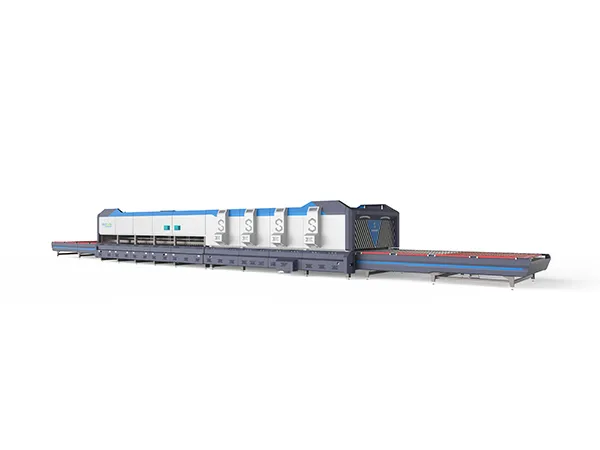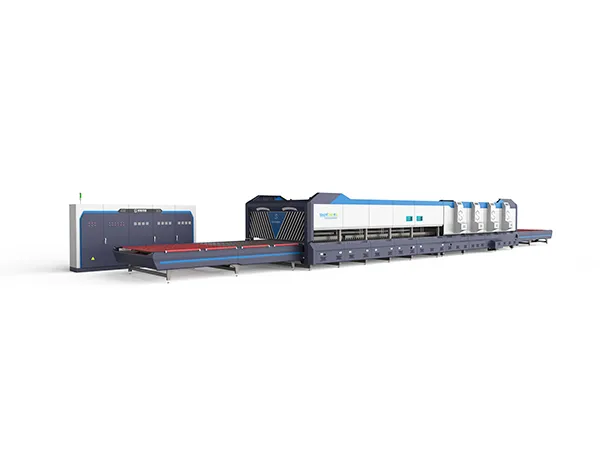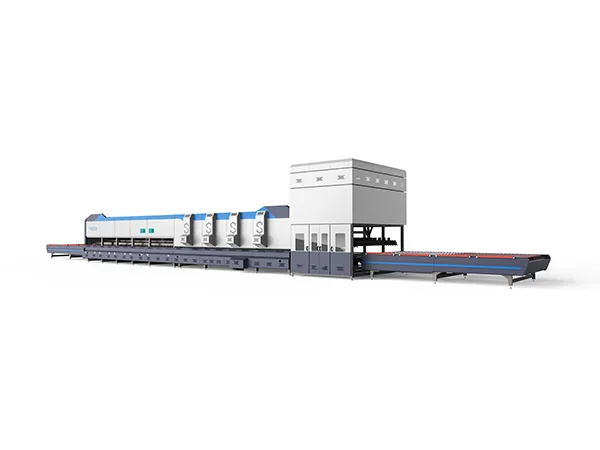The bending principle of a flat bending tempering furnace involves the process of heating flat glass to a specific temperature, allowing it to become pliable, and then bending it into a desired shape before cooling it down to temper the glass. This process is widely used in the production of curved or bent tempered glass, which is commonly used in automotive, architectural, and various other applications.
Bending principle of flat bending tempering furnace

1. Heating the Glass
Heating Process:
The flat glass is first placed on a roller bed or conveyor inside the tempering furnace.
The furnace heats the glass uniformly to a temperature typically between 600°C and 700°C, which is above the glass's softening point but below its melting point.
The heating is done in a controlled manner to ensure that the glass becomes soft and pliable without losing its shape or developing surface defects.
2. Bending the Glass
Gravity Bending:
In some systems, the glass is allowed to sag under its own weight into a pre-shaped mold or curved rollers as it softens. The mold defines the final shape of the glass.
The glass conforms to the mold's curvature as it is gradually bent into the desired shape.
Press Bending:
In other systems, mechanical presses or pneumatic devices are used to apply pressure on the softened glass, forcing it into the desired shape against a mold.
This method is more controlled and allows for more precise shaping, especially for complex or tight curves.
Roller Bending:
In continuous systems, the glass is passed over a series of rollers with varying heights and curvatures, which gradually bend the glass as it moves through the furnace.
3. Tempering the Glass
Quenching Process:
Once the glass has been bent to the desired shape, it is rapidly cooled using a process known as quenching.
Air jets are directed at the glass's surface, cooling it quickly while the interior cools more slowly.
This rapid cooling induces compressive stress on the surface and tensile stress inside the glass, resulting in tempered glass that is much stronger and more resistant to thermal stress and impact than annealed glass.

4. Cooling and Final Inspection
Cooling Stage:
After quenching, the glass is allowed to cool to room temperature in a controlled environment to stabilize its shape and properties.
The cooling process is carefully monitored to avoid introducing any warping or distortions.
Inspection:
The bent and tempered glass is then inspected for quality, ensuring that it meets the required specifications for shape, surface quality, and strength.
Key Principles Involved
Thermal Softening: The glass must be heated uniformly to a temperature where it becomes pliable without melting. This softening allows the glass to be bent into the desired shape.
Gravity and Mechanical Forces: Depending on the method used, gravity or mechanical forces shape the softened glass against a mold or through a series of rollers.
Rapid Cooling (Quenching): The rapid cooling process is critical in creating tempered glass, which has enhanced strength and safety characteristics due to the induced stresses.
Precision Control: The entire process requires precise control of temperature, timing, and mechanical actions to ensure the glass is bent accurately without introducing defects.

Applications
The bending tempering process is used to produce glass for various applications, including:
Automotive Glass: Curved windshields, rear windows, and side windows.
Architectural Glass: Bent glass for building facades, skylights, and interior design elements.
Furniture and Interior Design: Bent glass for tables, shelves, and other decorative items.
This process allows manufacturers to create durable, aesthetically pleasing curved glass that meets stringent safety standards.










